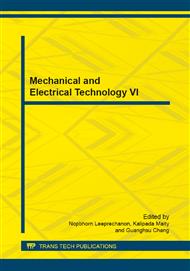[1]
L. W. Nagel. SPICE2: A computer program to simulate semiconductor circuits. Univ. California, Berkeley, CA, ERL-M520, May (1975).
Google Scholar
[2]
C. W. Ho, A. E. Ruehli and P. A. Brennan. The modified nodal approach to network analysis[J]. IEEE Trans. Circuits & Syst., 1975, CAS-22(6): 504-509.
DOI: 10.1109/tcs.1975.1084079
Google Scholar
[3]
J. M. Ortega and W. C. Rheinboldt. Iterative Solution of Nonlinear Equations in Several Variables, Academic Press, (1970).
DOI: 10.1016/b978-0-12-528550-6.50017-x
Google Scholar
[4]
R. C. Melville, L. Trajkovic, S. -C. Fang. and L. T. Watson. Artificial parameter homotopy methods for the DC operating point problem[J]. IEEE Trans. Cornput. -Aided Des. Integrated Circuits & Syst., 1993, CAD-12(6): 861-877.
DOI: 10.1109/43.229761
Google Scholar
[5]
K. Yamamura, T. Sekiguchi and Y. Inoue. A fixed-point homotopy method for solving modified nodal equations[J]. IEEE Trans. Circuits & Syst., 1999, 46(6): 654-665.
DOI: 10.1109/81.768822
Google Scholar
[6]
Y. Inoue, S. Kusanobu, K. Yamamura and M. Ando. A homotopy method using a nonlinear auxiliary function for solving transistor circuits[J]. IEICE Trans. Inf. & Syst., 2005, E88-D(7): 1401-1408.
DOI: 10.1093/ietisy/e88-d.7.1401
Google Scholar
[7]
W. Kuroki and K. Yamamura. An efficient homotopy method that can be easily implemented on SPICE[J]. IEICE Trans. Fundamentals, 2006, E89-A(11): 3320-3326.
DOI: 10.1093/ietfec/e89-a.11.3320
Google Scholar
[8]
Tadeusiewicz M and Hałgas S. A contraction method for locating all the DC solutions of circuits containing bipolar transistors[J]. Circuits Syst. Signal Process, 2012, 31(3): 1159–1166.
DOI: 10.1007/s00034-011-9362-1
Google Scholar
[9]
A. Ushida and L. O. Chua. Tracing solution curves of nonlinear equations with sharp turning points[J]. Int. J. Circuit Theory & Applications, 1986, 12(1): 1-21.
DOI: 10.1002/cta.4490120102
Google Scholar
[10]
Y. Inoue and S. Kusanobu. Theorems on the unique initial solution for globally convergent homotopy methods[J]. IEICE Trans. Fundamentals, 2003, E86-A(9): 2184-2191.
Google Scholar
[11]
Y. Inoue, S. Kusanobu, K. Yamamura and M. Ando. An initial solution algorithm for globally convergent homotopy methods[J]. IEICE Trans. Fundamentals, 2004, E87-A(4): 780-786.
DOI: 10.1109/iscas.2003.1204989
Google Scholar
[12]
A. Ushida, Y Yamagami, I. Kinouchi, Y Nishio and Y Inoue. An efficient algorithm for finding multiple DC solutions based on SPICE oriented Newton homotopy method[J]. IEEE Trans. Comput. -Aided Des. Integrated Circuits & Syst., 2002, CAD-21(3): 337-348.
DOI: 10.1109/43.986427
Google Scholar
[13]
Kazutoshi Sako, Hong Yu and Yasuaki Inoue. A globally convergent method for finding DC solutions of MOS transistor circuits[C]. IEEJ International Analog VLSI Workshop 2006, Hangzhou China, Nov. (2006).
Google Scholar
[14]
J. Roychowdhury and R. Melville. Delivering global DC convergence for large mixed-signal circuits via homotopy/continuation methods[J]. IEEE Trans. Comput. -Aided Des. Integr. Circuits & Syst., 2006, 25(1): 66-78.
DOI: 10.1109/tcad.2005.852461
Google Scholar
[15]
Dan Niu, Guangming Hu and Y. Inoue. Theorems on the global convergence of the nonlinear homotopy method for MOS circuits[C]. Proc. 2011 Asia Pacific Conference on Postgraduate Research in Microelectronics & Electronics, 2001, 41-44.
DOI: 10.1109/primeasia.2011.6075066
Google Scholar
[16]
Dan Niu, Kazutoshi Sako, Guangming Hu and Y. Inoue. A globally Convergence nonlinear homotopy method for MOS transistor circuits[J]. IEICE Trans. Fundamentals, 2012, E95-A(12): 2251-2260.
DOI: 10.1587/transfun.e95.a.2251
Google Scholar
[17]
Tadeusiewicz M, Hałgas S. A method for finding multiple DC operating points of short channel CMOS circuits[J]. Circuits Syst. Signal Process, 2013, 32(5): 2457-2468.
DOI: 10.1007/s00034-013-9582-7
Google Scholar
[18]
Yasuaki Inoue. DC analysis of nonlinear circuits using solution-tracing circuits[J]. Electronics and Communications in Japan, 1992, 75(7): 52-63.
DOI: 10.1002/ecjc.4430750706
Google Scholar


